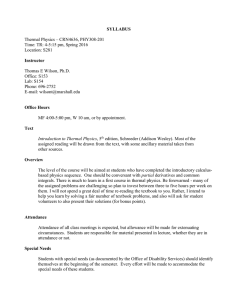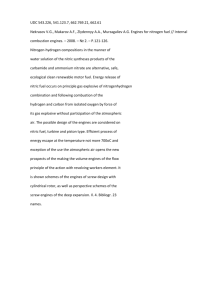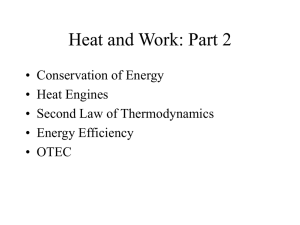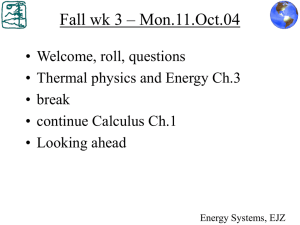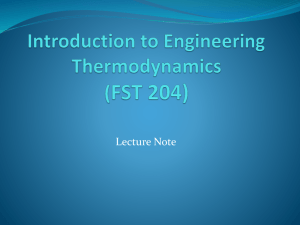Thermal to Mechanical Energy Conversion Engines and
advertisement
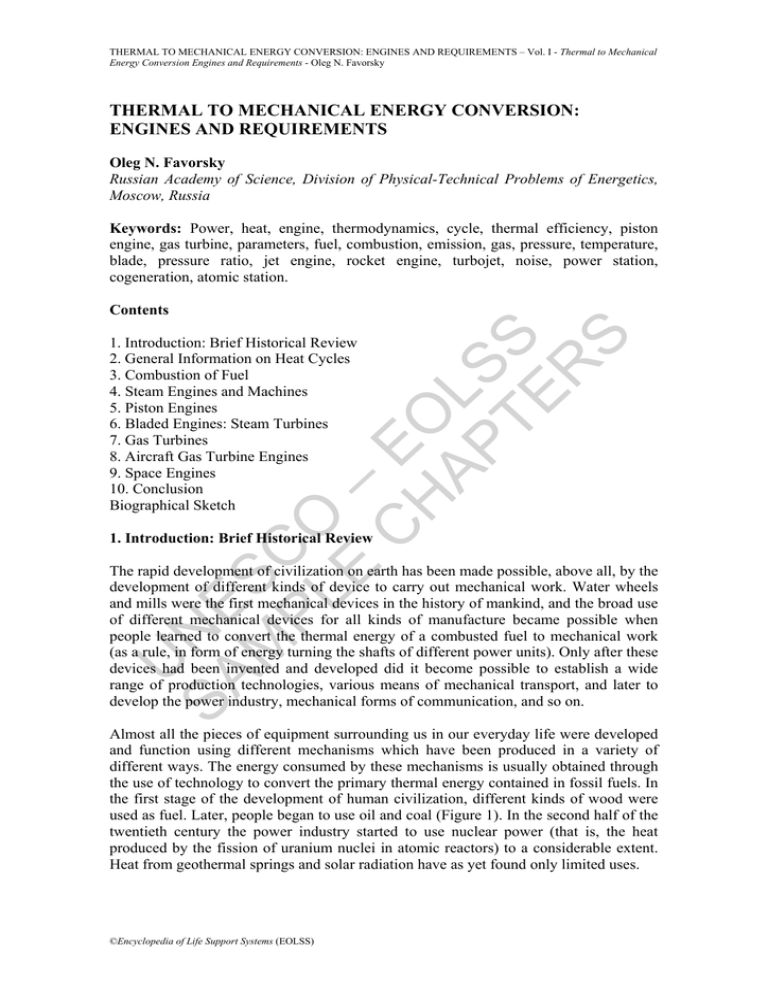
THERMAL TO MECHANICAL ENERGY CONVERSION: ENGINES AND REQUIREMENTS – Vol. I - Thermal to Mechanical Energy Conversion Engines and Requirements - Oleg N. Favorsky THERMAL TO MECHANICAL ENERGY CONVERSION: ENGINES AND REQUIREMENTS Oleg N. Favorsky Russian Academy of Science, Division of Physical-Technical Problems of Energetics, Moscow, Russia Keywords: Power, heat, engine, thermodynamics, cycle, thermal efficiency, piston engine, gas turbine, parameters, fuel, combustion, emission, gas, pressure, temperature, blade, pressure ratio, jet engine, rocket engine, turbojet, noise, power station, cogeneration, atomic station. U SA NE M SC PL O E – C EO H AP LS TE S R S Contents 1. Introduction: Brief Historical Review 2. General Information on Heat Cycles 3. Combustion of Fuel 4. Steam Engines and Machines 5. Piston Engines 6. Bladed Engines: Steam Turbines 7. Gas Turbines 8. Aircraft Gas Turbine Engines 9. Space Engines 10. Conclusion Biographical Sketch 1. Introduction: Brief Historical Review The rapid development of civilization on earth has been made possible, above all, by the development of different kinds of device to carry out mechanical work. Water wheels and mills were the first mechanical devices in the history of mankind, and the broad use of different mechanical devices for all kinds of manufacture became possible when people learned to convert the thermal energy of a combusted fuel to mechanical work (as a rule, in form of energy turning the shafts of different power units). Only after these devices had been invented and developed did it become possible to establish a wide range of production technologies, various means of mechanical transport, and later to develop the power industry, mechanical forms of communication, and so on. Almost all the pieces of equipment surrounding us in our everyday life were developed and function using different mechanisms which have been produced in a variety of different ways. The energy consumed by these mechanisms is usually obtained through the use of technology to convert the primary thermal energy contained in fossil fuels. In the first stage of the development of human civilization, different kinds of wood were used as fuel. Later, people began to use oil and coal (Figure 1). In the second half of the twentieth century the power industry started to use nuclear power (that is, the heat produced by the fission of uranium nuclei in atomic reactors) to a considerable extent. Heat from geothermal springs and solar radiation have as yet found only limited uses. ©Encyclopedia of Life Support Systems (EOLSS) U SA NE M SC PL O E – C EO H AP LS TE S R S THERMAL TO MECHANICAL ENERGY CONVERSION: ENGINES AND REQUIREMENTS – Vol. I - Thermal to Mechanical Energy Conversion Engines and Requirements - Oleg N. Favorsky Figure 1. Utilization of fuel resources: 1 – Natural gas; 2 – Oil; 3 – Coal; 4 – Nuclear energy; 5 – Biomass; 6 – Recoverable resources Regardless of the fuel source, the technology usually consists of a method for the conversion of gas (created through the combustion of fuel in air, or the generation of steam from heating water) into mechanical work. This work may consist of turning a shaft, driving mechanisms, or causing objects of any kind to move. The amount of energy required to move objects is determined by their mass (M) and speed (or velocity, V). It is specified by the formula MV2/2, and is called the kinetic energy of the object. The main laws regulating all these relationships are the law of energy conservation and its analogue, the first law of thermodynamics. The principle of the conservation of matter and energy was formulated for the first time by the great Russian scientist Lomonosov in 1747: “If a body loses a certain quantity of matter then another body shall gain the same quantity. . . . When a body moves by its own power another body loses as much power as the first body gains.” In the middle of the nineteenth century the chemist G. H. Hess created thermochemistry: the science that is concerned with heat emission or consumption during the chemical transformations of substances. The physicist E. H. Lenz discovered how to convert another type of energy—electrical energy—into heat, and determined the amount of heat emitted by an electric current passing through a conductor. Between 1842 and 1850 several scientists discovered independently from each other the law of equivalence of heat and mechanical work. In their various experiments they ©Encyclopedia of Life Support Systems (EOLSS) THERMAL TO MECHANICAL ENERGY CONVERSION: ENGINES AND REQUIREMENTS – Vol. I - Thermal to Mechanical Energy Conversion Engines and Requirements - Oleg N. Favorsky determined the value of the mechanical equivalent of heat: that is, the number of kilogram-meters of mechanical work that could be obtained from the complete conversion of one kilocalorie of heat. This led to the introduction of technical thermodynamics, the science that solves problems connected with the conversion of thermal energy to mechanical work in heat engines (steam machines, internal combustion engines, and so on). U SA NE M SC PL O E – C EO H AP LS TE S R S The foundations of thermodynamics are encapsulated in two main laws. The first law of thermodynamics states in numerical terms how thermal and mechanical energy are transformed into each other in the course of various thermodynamic processes. For example, if in a certain process one kilocalorie of heat is completely converted into the mechanical energy then it provides 427 kilogram-meters of mechanical energy (work). The essence of the fist law of thermodynamics can be formulated as follows: in the transformation of heat into mechanical energy or vice versa, a fixed quantity of heat always corresponds to a fixed quantity of mechanical energy. The law states that it is impossible under any conditions and in any constructive form to build an engine that can produce work without consuming any energy: in other words, it proves that it is impossible to create a machine which produces perpetual motion without any fuel source. The second law of thermodynamics (formulated for the first time by the French engineer S. Carnot) determines the conditions in which thermal energy can be converted into mechanical work. The main condition is that heat (which is a reflection of molecular movement) can pass from a body with a higher temperature to a body with a lower temperature, but not vice versa. It is possible to harness the energy created when water falls from a higher to a lower level, but an energy source is needed to make water rise from a lower level to a higher level. Similarly, it is possible to obtain work from heat only when it passes from a heat carrier with a higher temperature to a heat carrier with a lower temperature; to do the reverse would require an energy input. Furthermore, just as it is not possible to make use of all the potential energy contained in the water as a result of its height (unless it were possible to make the water fall down to the center of the earth), so it is not possible to convert all the heat contained in a heat carrier to mechanical work, since the amount available is limited by the lowest temperature level to which the heat carrier can viably be brought (which is determined by the ambient temperature). In other words, the second law of thermodynamics states that in order to convert thermal energy to mechanical energy, there must be a temperature differential. The law also dictates that it is not possible to construct a machine that can produce work only by means of cooling a body without simultaneously heating another body. Devices used to convert thermal energy to mechanical energy are called heat engines. 2. General Information on Heat Cycles Heat engines can be divided into steam engines and gas engines, according to the kind of working fluid used. They can also be divided into two main types according to the character of the energy transformations they bring about: engines with a periodically interrupted movement of the mechanism converting the energy of the working fluid pressure to the mechanical work; and engines with a continuous movement of the ©Encyclopedia of Life Support Systems (EOLSS) THERMAL TO MECHANICAL ENERGY CONVERSION: ENGINES AND REQUIREMENTS – Vol. I - Thermal to Mechanical Energy Conversion Engines and Requirements - Oleg N. Favorsky mechanism converting the kinetic energy of the moving working fluid into the work. The first type includes all piston engines: steam machines and internal combustion engines, where the energy of the supplied working fluid (steam or gas) acts in the form of pressure on a piston which performs forward and backward movements in a cylinder. This movement is then transmitted to the rotating main shaft by means of a special crank and conrod gear. The second type includes bladed engines: steam and gas turbines where the energy of the working fluid is received by the main part of the turbine continuously rotating in a cylinder. The rotor consists of a shaft bearing the parts which receive the kinetic energy of the moving working fluid (discs or a drum with rotating blades). U SA NE M SC PL O E – C EO H AP LS TE S R S The core activity in thermal to mechanical energy conversion schemes takes place in a working fluid that is a heat carrier. This is usually either steam (in steam machines and steam turbines) or the products of fuel combustion in the air (using the oxygen in the air as an oxidizer). The process of changes in the parameters of the heat carrier (its temperature and pressure) is usually called a thermal cycle. In heating engineering it is important to know how a change in one of the working fluid parameters creates a change in another parameter: for example, how the pressure of a certain amount of gas changes when its specific volume changes, and vice versa. These interdependencies in the parameters are usually pictured graphically in the form of diagrams and curves. The investigation method that uses geometrical drawings (curves, areas of figures, and so on) is called the graphical method, and is a very good means for the visual presentation of different processes and their results when certain mathematical expressions have to be compared. It simplifies the solution of a whole number of calculation tasks, and often makes it possible to estimate operation factors sufficiently precisely for practical purposes, without the need to carry out detailed calculations. Besides this mathematical substantiation, technical thermodynamics also uses the graphical method to explain visually the theoretical processes with all their internal dependencies and relationships. The term “thermal cycle” refers to the combination of processes taking place in a working fluid that convert the heat fed into the cycle (the system) to mechanical work, and return the system to its initial state (that is, making the cycle capable of repetition). According to the laws of thermodynamics it is only possible to generate power that can be utilized in one way or another from a certain working fluid—that is, a volume (mass) of a gas (steam) working in a machine—by expanding its volume or reducing its pressure. If in the beginning of the operation cycle of a machine the heat carrier contains the heat quantity Q1, then it transfers a proportion of Q1, namely Q2, of that heat to a cold source, then the difference Q1 –Q2 (but not all the heat Q1) will be converted to mechanical work. According to the first law of thermodynamics this difference provides (Q1 – Q2) of mechanical energy. Thus, because part of the heat must be given to the cold source, the efficiency of a heat engine is always lower than 1 (100 percent). At the same time, the bigger the temperature difference between the initial and the end state of the heat carrier, the bigger the difference between the heat quantities Q1 and Q2, and the higher the efficiency. ©Encyclopedia of Life Support Systems (EOLSS) THERMAL TO MECHANICAL ENERGY CONVERSION: ENGINES AND REQUIREMENTS – Vol. I - Thermal to Mechanical Energy Conversion Engines and Requirements - Oleg N. Favorsky U SA NE M SC PL O E – C EO H AP LS TE S R S The amount of the expansion work can be visualized by an area in the co-ordinate system of the working fluid parameters P (pressure) and v (specific volume, that is, the ratio of gas volume V to gas weight G) (see Figure 2). As a rule the temperature of the working fluid decreases during the expansion process from its initial value T1 down to its end value T2. In order to obtain work from a working fluid not only once but constantly, the working fluid must be returned to its initial state (P1, T1). To do this it must be cooled, then compressed again (its pressure must be increased) and then heated again. As a result of a combination of these processes a closed process—a cycle— appears. (These main processes are shown in Figure 3.) The shaded area in Figure 3 represents the useful work of a heat to mechanical energy conversion cycle. Thus, this is a difference between the expansion work and the compression work Lcycle sp = Lexp – Lcomp. In this case Lsp means specific work, that is, the work obtained from a 1 kg/s (kilogram per second) mass flow of the working fluid. At this point it should be noted that the power output of a thermal machine with such a cycle is determined by the product of the working fluid mass flow G multiplied by the specific work: N = LspG. That is, to produce a more powerful machine it is necessary to create a higher mass flow of the working fluid, and this means that the machine itself needs to be bigger. Figure 2. Potential generation of energy through changes in the pressure and specific volume of a gas In a water steam cycle the steam is condensed to water during the cooling: this is the main difference between this cycle and that of a gas cycle. Less energy is needed to increase the pressure of a liquid required than to compress of a gas. That is why steam machines tend to be more efficient than gas machines with the same T1 and T2. ©Encyclopedia of Life Support Systems (EOLSS) THERMAL TO MECHANICAL ENERGY CONVERSION: ENGINES AND REQUIREMENTS – Vol. I - Thermal to Mechanical Energy Conversion Engines and Requirements - Oleg N. Favorsky U SA NE M SC PL O E – C EO H AP LS TE S R S Another peculiarity of gas machines is the fact that as a rule the working fluid—a hot gas—is formed as a result of burning the fuel in the air, while in contrast the steam in steam engines is usually heated by the combustion products through the metallic walls of a boiler. As a result, it is possible to generate higher working fluid temperatures and, again, higher efficiencies in gas engines. When a fuel is burned in the air the initial oxygen content of the air drops drastically (atmospheric air contains approximately 21 percent by weight of oxygen) and carbon oxides and water vapor are formed, mainly from the fuel. It is not possible to create a closed cycle and reuse the same air because of this reduced oxygen content. The combustion products must be removed to the environment, and a new portion of fresh air must be taken in. This process is shown by the dotted line in Figure 3 (process 4–1). This process is called quasi (as if) closure of a cycle. In effect, no gas combustion engines are real closed-cycle machines, since this is true of all of them. Figure 3. The thermal cycle shown in form of a pressure–volume diagram In any case, both in the steam cycle (where the working fluid can be preserved) and in the gas cycle (where the initial air must be exchanged) the thermodynamics require that after the expansion of the working fluid is finished, the heat must be removed from it into the environment (by means of cooling the steam or exchanging the gas). This very condition, as was mentioned above, can be formulated mathematically as the second law of thermodynamics. For any type of energy conversion system it is first of all important to know the principal limits of possible useful work extraction L and thermal efficiency. The thermal efficiency can be written as a ratio of the heat equivalent to the useful work to the heat ©Encyclopedia of Life Support Systems (EOLSS) THERMAL TO MECHANICAL ENERGY CONVERSION: ENGINES AND REQUIREMENTS – Vol. I - Thermal to Mechanical Energy Conversion Engines and Requirements - Oleg N. Favorsky contained in the consumed fuel: η = N/QT, or using the specific fuel consumption: Ce = Q fuel /Lsp – 1/η. The main feasible way to increase the cycle efficiency is to increase the working fluid temperature range Tmax and Tmin, in order to achieve a maximum Tmax allowed by the strength of the materials of the real design, and a minimum Tmin determined by the surrounding atmosphere. (The internationally accepted standard conditions are +15 °C or 288 K). U SA NE M SC PL O E – C EO H AP LS TE S R S The most effective cycle is the so called ideal cycle, or the Carnot cycle (see Figure 4). The useful work of this cycle is Lsp = Cp (Tmax – Tmin) = CpTmax(1 – Tmin / T max), and the cycle efficiency is η = 1 – Tmin / Tmax, where Cp is the specific heat of the working fluid (kcal/kg deg). For example: taking the air as the working fluid and Tmax = 1000 °C, T min = 15 °C we can obtain the maximum specific work of the Carnot cycle, which is about 1000 kW from each kg/h air, and the maximum efficiency, 78 percent. This means that the corresponding actual parameters of a conversion system must always be lower—and even considerably lower—than these values. Further we will show that in the best systems widely used today the difference is about 50 percent. Figure 4. Ideal thermal cycle (the Carnot cycle) plotted on the axes T (temperature) and S (entropy) At the same time the significance of the analysis of the ideal cycle lies in the fact that it makes it possible to find the main ways to improve any kind of energy conversion systems, and those are the trends to increase the maximum cycle temperature and/or the cycle temperature ratio. In fixed standard ambient atmospheric conditions (Tmin) we can see that the work of the Carnot cycle grows faster than just proportionally to Tmax, and the efficiency increase is smaller. The increase in the cycle temperature is the main factor moving forward the development of heating engineering. ©Encyclopedia of Life Support Systems (EOLSS) THERMAL TO MECHANICAL ENERGY CONVERSION: ENGINES AND REQUIREMENTS – Vol. I - Thermal to Mechanical Energy Conversion Engines and Requirements - Oleg N. Favorsky - TO ACCESS ALL THE 39 PAGES OF THIS CHAPTER, Visit: http://www.eolss.net/Eolss-sampleAllChapter.aspx Biographical Sketch U SA NE M SC PL O E – C EO H AP LS TE S R S Academician Oleg Favorsky was born in 1929 in Saratov, Russia. He graduated in 1951 from the Moscow Aviation Institute, and had got his Ph.D. in 1956 and Doctorate in Technical Sciences in 1966. Since 1951 he has worked in the aviation industry. From 1973 to 1987 he took up the post of Chief Designer and Director General of Moscow Aircraft Engine Production Association “Soyuz.” From 1972 to 1994, he was a member of the USSR Academy of Sciences, Vice-Chairman and Chairman of the Gas Turbine Commission of the Academy, and Deputy Academician-Secretary for energetics. From 1994 to the present time he is the Academician-Secretary, Head of Division of Physical-Technical Problems of Energetics of the Russian Academy of Sciences (RAS), and a Member of the Presidium of RAS. His scientific interests are thermodynamic and gas dynamics, land and space transformation of heat energy into electric energy, and aviation engine design. He has Honorary Membership of the Vice-Presidency of the International Academy of Energetics (1994), and the Russian Academy of Flight and Aviation (1995). He was awarded the Laureate of Lenin (1982) and State (2000) Prizes, and he is the author of more than 200 publications, including six books on five types of aviation engine. ©Encyclopedia of Life Support Systems (EOLSS)
